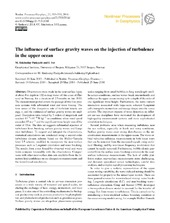The influence of surface gravity waves on the injection of turbulence in the upper ocean
Peer reviewed, Journal article
Published version
Permanent lenke
https://hdl.handle.net/1956/8685Utgivelsesdato
2014-06-25Metadata
Vis full innførselSamlinger
- Geophysical Institute [1195]
Originalversjon
https://doi.org/10.5194/npg-21-713-2014Sammendrag
Observations were made in the near-surface layer, at about 8 m depth in 132 m deep water off the coast of Ålesund in Norway, for a duration of 2.5 months in late 2011. The measurement period covers the passage of two low pressure systems with substantial wind and wave forcing. The time series of the dissipation rate of turbulent kinetic energy, ε, and the estimates of surface gravity waves are analysed. Dissipation rates varied by 5 orders of magnitude and reached 10−5–10−4Wkg−1 in conditions when wind speed exceeded 15m s−1 and the significant wave height was of the order of 10 m. The data set suggests substantial injection of turbulence from breaking surface gravity waves and Langmuir turbulence. To support and interpret the observations, numerical calculations are conducted using a second-order turbulence closure scheme based on the Mellor–Yamada level 2.5 scheme, modified to incorporate the near-surface processes such as Langmuir circulation and wave breaking. The results from a run forced by observed wind and wave fields compare favourably with the observations. Comparisons with other near-surface data sets available from the literature lend confidence on our dissipation measurements and the wave-forced simulations.

